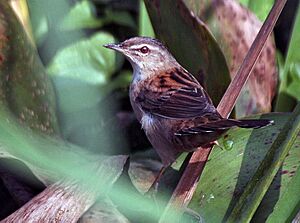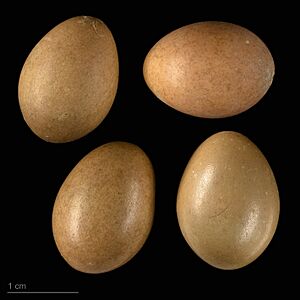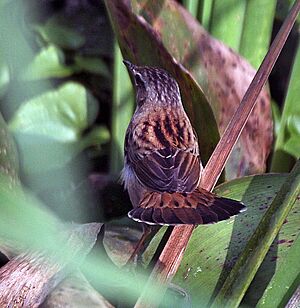Pallas's grasshopper warbler facts for kids
Quick facts for kids Pallas's grasshopper warbler |
|
|---|---|
 |
|
| In Kolkata, West Bengal, India. | |
| Conservation status | |
| Scientific classification | |
| Genus: |
Helopsaltes
|
| Species: |
certhiola
|
| Synonyms | |
|
|
The Pallas's grasshopper warbler (Helopsaltes certhiola) is a small bird also known as the rusty-rumped warbler. It belongs to a group of birds called Old World warblers. These birds are found in many parts of the world.
This warbler breeds in eastern Asia. You can find it from the Altai Mountains in Mongolia to northeastern China. It also lives on the Korean Peninsula and islands near the Sea of Okhotsk.
Pallas's grasshopper warblers are migratory. This means they travel long distances. They spend their winters in warmer places. These areas include India and Indonesia. Sometimes, a few birds might even fly as far as Sri Lanka.
Contents
About Its Name
This bird was named after a German scientist. His name was Peter Simon Pallas. He was the first person to describe this bird in 1811.
The second part of its scientific name, certhiola, means "little treecreeper." This is because it was once thought to be related to birds called treecreepers.
You might hear this bird called "Pallas's warbler." However, that name is more often used for a different bird. That other bird is called Phylloscopus proregulus.
Where It Lives
This small passerine bird likes to live in areas with tall grass. It prefers places with some thicker plants too. You will often find it near water, like in bogs or wet meadows.
The Pallas's grasshopper warbler builds its nest on the ground. It hides the nest in the grass. A female bird usually lays between 4 and 7 eggs.
Sometimes, these birds fly far from their usual homes. They can be seen in western Europe. One good place to spot them is Fair Isle in the Shetland Islands. Even though they are rare visitors, they appear there quite often.
What It Looks Like
The Pallas's grasshopper warbler is a medium-sized bird. Its back is brown with streaks. Its belly is whitish-grey. The underside of its tail might have some streaks.
Male and female birds look the same. This is common for many warblers. Young birds, however, have a more yellow color on their undersides. Like most warblers, they eat insects.
This bird looks a lot like the common grasshopper warbler. But the Pallas's grasshopper warbler is a bit bigger. It also has white tips on its tail feathers. Its rump (the area above its tail) is a warmer brown color. The white tips on its tail are why some people call it "PG Tips." This is a fun way to remember it.
This warbler is very good at hiding. It's hard to see unless it's singing. It moves quietly through grass and low plants.
Its Song
The song of the Pallas's grasshopper warbler is special. It's not a simple, insect-like buzzing sound. Many other Locustella warblers make that kind of sound. Instead, this bird sings a creative, musical tune. It sounds more like the songs of Acrocephalus warblers.
Types of Pallas's Grasshopper Warblers
Scientists recognize five different types, or subspecies, of this bird:
- H. c. rubescens Blyth, 1845
- H. c. sparsimstriatus Meise, 1934
- H. c. certhiola (Pallas, 1811)
- H. c. centralasiae Sushkin, 1925
- H. c. minor David & Oustalet, 1877




